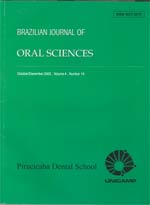
|
Brazilian Journal of Oral Sciences
Piracicaba Dental School - UNICAMP
EISSN:
Vol. 3, No. 9, 2004, pp. 433-438
|
 Bioline Code: os04011
Bioline Code: os04011
Full paper language: English
Document type: Research Article
Document available free of charge
|
|
|
Brazilian Journal of Oral Sciences, Vol. 3, No. 9, 2004, pp. 433-438
| en |
Influence of the filling technique on depth of tubular penetration of root canal sealer: a scanning eletron microscopy study
Gustavo De-Deus; Eduardo Diogo Gurgel-Filho; Cláudio Maniglia-Ferreira & Tauby Coutinho-Filho
Abstract
The purpose of this study was to compare the depth of tubular dentinal penetration of sealer in three filling techniques. Seventy two teeth maxillary central incisors were instrumented and randomly divided in three groups A, B and C and obturated as following: A: lateral condensation; B: single cone technique and C: warm vertical compaction of guttapercha. Each sample was sectioned longitudinally and prepared for SEM analysis. The results revealed a depth of tubular penetration varying from 19 to 81mm, presenting an average post of 34 ± 16mm for G1; 26 to 101mm, presenting an average post of 44 ± 28mm for G2 and 22 to 188mm, presenting an average post of 67 ± 37mm for G3. A non-parametric ANOVA Kruskall-Wallis was used to determine whether there were significant differences among the groups, which identified significant differences between G3 and G1 (P = 0.021) and between G3 and G2 (P = 0.009). There were no significant differences between G1 and G2 (P> .05). The samples filled by warm vertical compaction of gutta-percha presented significantly deeper tubular sealer penetration than lateral condensation and single cone techniques.
Keywords
filling technique, tubular penetration, root canal sealer.
|
| |
© Copyright 2004 - Piracicaba Dental School - UNICAMP São Paulo - Brazil
Alternative site location: http://www.fop.unicamp.br/brjorals
|
|
